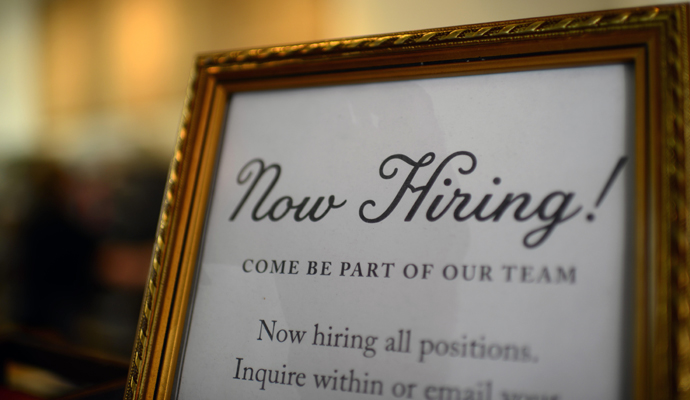Inside Walmart’s Wage Hike
A raise for the lowest-paid workers won’t end economic inequality—but it might force other companies to rethink their compensation at the bottom.
The event was covered with all the hoopla of a major product unveiling or a mega-merger. CNBC sent an anchor to the company headquarters. The publicity machines revved up. What was the big occasion? On February 19, Walmart, the largest U.S. retailer, announced it would be raising wages for several thousand of its lowest-paid workers. “For our current associates, we’ll start by raising our entry wage to at least US$9 an hour in April, and, by February of next year, all current associates will earn at least $10 an hour,” said CEO Doug McMillon.
But before painting McMillon as the second coming of Henry Ford, who scandalized and revolutionized the United States in 1914 by doubling wages of his production workers to $5 a day, it’s worth reflecting on what Walmart’s move means—and what it doesn’t mean.
On purely economic grounds, perhaps there is less here than meets the eye. The federal minimum wage has been stuck at $7.25 since 2009. But states and cities in recent years have been raising their local minimum wages significantly. In California, which is home to 12 percent of the U.S. population and hundreds of Walmart outlets, the minimum wage rose to $9 in 2014 and is slated to jump to $10 next year. To a degree, Walmart was simply announcing that it would adhere to the changes in many states where it operates.
While going from $7.25 to $9 is a meaningful increase, a rise of 24 percent in one fell swoop, the number of people directly affected by the move is relatively small. The overwhelming majority of Walmart’s workers are paid above the minimum wage, and the average employee earns $12.85 per hour. The new pay structure will raise the company’s total wage bill by $1 billion—about what the retailer, which had global sales of $485 billion in 2014, racks up in 10 hours. One billion dollars of extra wages in a $17 trillion economy won’t solve the problems of income inequality and persistently low wages. A person working at $9 an hour, 40 hours per week, 50 weeks a year, earns $18,000 a year. The official poverty line in the U.S. for a family of three is $20,090. Nor does this extra $1 billion represent a massive loosening of Walmart’s purse strings. At its current dividend rate of $1.92 per share, Walmart is on track to pay out about $6.2 billion in dividends to stockholders.
But here’s why it does matter. Walmart, for years, has staked its business model on controlling costs in a blunt fashion. That meant paying as little as possible for every input—packaging, products, logistics, energy, and labor. And who could blame the company? It subsists on thin margins in a highly competitive business, and it passes on all the savings to its customers, who are perpetually pinched. By and large, Walmart has not had a problem hiring associates at the comparatively low wages it offers.
The company’s recent move marks an important intellectual and cultural shift. In recent years, the experience of the typical shopper at a Walmart has suffered from inefficiencies, and the company’s results have reflected that customer dissatisfaction. But for a long time, the company’s leadership didn’t draw any connection between its wages and the in-store experience. That seems to have changed with the installation of a new CEO in late 2013. As Bloomberg reported, “[CEO Doug] McMillon made surprise visits to Walmart stores and didn’t like what he saw: long checkout lines, empty shelves and problems with produce.” McMillon quickly came to realize that if he was going to fix the retail experience, he would have to reduce turnover and provide more motivation to employees.
To fix the retail experience, provide more motivation to employees.
To maintain its workforce, Walmart has to hire and train thousands of new people each week. As the expansion continues and labor markets tighten—the unemployment rate fell to 5.7 percent in February, and at the end of January there were 5.02 million job openings in the U.S.—it is becoming harder for all sorts of companies to hold on to workers. In an expansionary climate, many of the people Walmart trains (especially the ambitious ones with marketable skills) will leave for greener pastures. And so the self-imposed minimum wage increase was part of a larger package McMillon introduced aimed at making workers happier, including adopting more fixed schedules and raising wages for managers and experienced workers. “Approximately 500,000 associates will receive a raise from these changes in the first half of this year,” the company noted.
Slashing turnover can mean cutting costs associated with hiring and training. The Wall Street Journal, crunching some data from an old study on the experience of companies at the San Francisco airport, where a sharply higher minimum wage was imposed, concluded (tentatively), “If Walmart has 50 percent turnover among associates and logs a similar 34 percent decline in quitting among the 500,000 workers who will receive bigger paychecks, the retailer would save more than $350 million.”
Another important point: Walmart is a huge player in a significant sector in the economy, and one that others have to compete with and benchmark against. As economist Justin Wolfers, a senior fellow at the Brookings Institution, noted, retail is about 10 percent of U.S. employment, and Walmart is about 10 percent of retail employment. According to the Bureau of Labor Statistics, retail employment stands at about 15.5 million. Walmart has effectively put down a marker for other big-box retailers. Given these changes, to the extent workers have a choice, they might start walking across the street to Walmart in pursuit of higher wages. On February 25, TJX, which as parent company to T.J. Maxx, Marshall’s, and other retailers operates some 26,000 stores across the U.S., said it would raise its minimum wage to $9 per hour in June. Expect more such announcements in the future.
Finally, Walmart’s move highlights a crucial factor. I would argue that norms surrounding pay matter a great deal. In the current economic recovery, it has become acceptable, even de rigueur, for companies not to raise wages even as their profits boom. And CEOs who held the line on salaries for lower-level employees, even as their own bonuses grew, didn’t suffer any sanction in the market of public opinion, or in their business.
But a highly public move like the one Walmart just made can help alter the norms and the conversation surrounding wages. There are signs that it might be taking its cue from a high-flying startup like Shake Shack. Think more broadly about the true costs and benefits involved in keeping wages low. Instead of paying lip service to the importance of human capital, put your money where your mouth is. And if you treat people a little better than the law—and the market—absolutely require you to, it can be good for your brand, your business, and ultimately, for your stock.






